Canine hip dysplasia (CHD) stands as the most prevalent inherited musculoskeletal condition affecting dogs. While surgical interventions offer solutions for managing CHD, the majority of affected dogs are often managed conservatively through a combination of supplements and pain medicine specifically designed for hip dysplasia in dogs. This comprehensive guide will explore 10 effective strategies for conservative management, delving into non-surgical treatments that can significantly improve the quality of life for dogs suffering from this condition, as shared by integrative veterinarian Dr. Julie Buzby.
Canine hip dysplasia is characterized by a congenital malformation of one or both hip joints in dogs. This condition frequently leads to the development of arthritis and chronic joint pain. Although surgical treatment for CHD can be the optimal choice in certain scenarios, particularly for severe cases or young dogs, it is an invasive, costly procedure that often necessitates a board-certified veterinary surgeon and specialized hospital care. For many dog owners, surgery may not be a viable or preferred option due to these factors. Fortunately, a study published in the Journal of Small Animal Practice indicates that approximately three-quarters of dogs with hip dysplasia and secondary arthritis can live comfortable and normal lives with appropriate conservative care. This underscores the importance of understanding and implementing effective pain management and support strategies for dogs with hip dysplasia.
Understanding Hip Dysplasia: Diagnosis and Clinical Signs
To effectively manage canine hip dysplasia, it is crucial to first understand the condition itself and how it is diagnosed. The hip joint is a classic “ball and socket joint.” In a healthy dog, the acetabulum (socket) fully encompasses the head of the femur (ball), ensuring the hip joint remains securely in place. Dogs with hip dysplasia, however, have malformed bones that prevent complete acetabular coverage. This anatomical abnormality results in laxity within the hip joint, making it prone to instability and even dislocation. Understanding what causes hip dysplasia in dogs can significantly inform the treatment approach.
The diagnostic process for canine hip dysplasia typically begins with a detailed history provided by the owner, observation of clinical signs, a thorough physical examination, and then proceeds to diagnostic tests such as X-rays and bloodwork. Early detection and diagnosis are key to initiating effective Pain Medicine For Dogs With Hip Dysplasia and improving long-term outcomes.
Clinical Signs of Hip Dysplasia
The clinical signs of hip dysplasia can often manifest at a young age and may be subtle, making early detection challenging for some owners. One of the earliest indications might be a distinctive “bunny-hopping” gait, where the dog’s back legs move together in a hopping motion when walking or running. In young dogs without significant arthritis, this might be the only noticeable symptom.
As dogs age, they often develop secondary arthritis due to the chronic stress and instability in the hip joints. This progression leads to increased pain and inflammation. Signs of arthritis stemming from hip dysplasia can include a range of symptoms that impact a dog’s mobility and overall well-being. Owners should be vigilant for:
- Difficulty or reluctance to rise after resting
- Stiffness, particularly after prolonged periods of lying down
- Noticeable loss of muscle mass in the rear limbs, indicating disuse or compensation
- A tendency to shift weight to the front legs to alleviate pressure on the painful hips
- Intermittent limping that may shift between legs
- Reluctance to engage in activities they once enjoyed, such as running, climbing stairs, or jumping
The following image illustrates the anatomical differences between a normal hip and a dysplastic, arthritic hip in a dog. This visual helps underscore the structural issues that lead to chronic pain and mobility challenges in affected dogs.
 Plastic model comparing a normal dog hip with a dysplastic, arthritic hip
Plastic model comparing a normal dog hip with a dysplastic, arthritic hip
Veterinarian Confirmation Through X-rays
Your veterinarian will conduct a comprehensive physical examination to pinpoint the cause of your dog’s lameness. During this exam, they will assess for signs of pain when manipulating the hips through their full range of motion. They might also check for the Ortolani sign, which is an audible “clunk” sound produced when manipulating a dysplastic hip. It is important to note that the Ortolani sign may not always be detectable in a tense patient, and therefore, a sedated physical exam might be necessary for a more accurate assessment.
X-rays are typically definitive for confirming a diagnosis of hip dysplasia. The images below provide a visual comparison of dogs with healthy hips and those with hip dysplasia, clearly illustrating the anatomical differences.
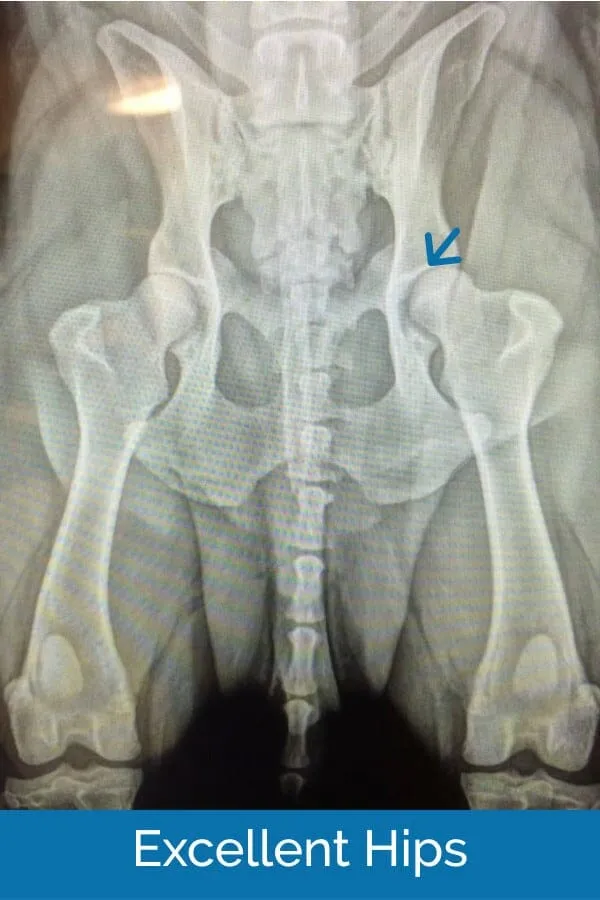 X-ray of a dog with excellent hip conformation, certified by the OFAThis dog’s hips received an “excellent” certification from the Orthopedic Foundation for Animals (OFA). The OFA defines “excellent” as “Superior conformation; there is a deep-seated ball (femoral head) which fits tightly into a well-formed socket (acetabulum) with minimal joint space.” Photo credit: Debra Cohen, RVT.
X-ray of a dog with excellent hip conformation, certified by the OFAThis dog’s hips received an “excellent” certification from the Orthopedic Foundation for Animals (OFA). The OFA defines “excellent” as “Superior conformation; there is a deep-seated ball (femoral head) which fits tightly into a well-formed socket (acetabulum) with minimal joint space.” Photo credit: Debra Cohen, RVT.
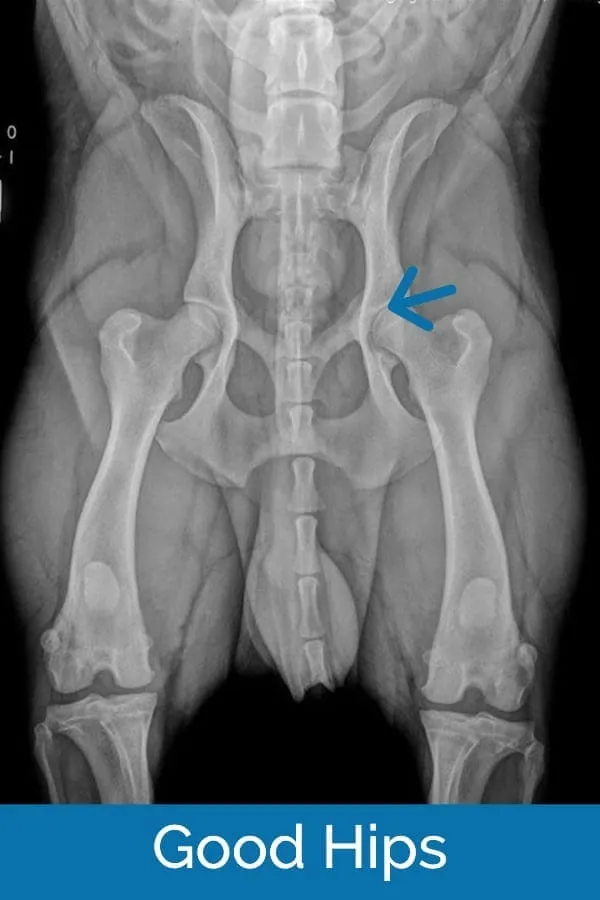 X-ray of a dog with good hip conformation, rated by the OFAThis X-ray belongs to a five-year-old Labrador Retriever whose hips were rated “good” by the Orthopedic Foundation for Animals. The OFA criteria for “good” states, “*Slightly less than superior but a well-formed congruent hip joint is visualized. The ball fits well into the socket and good coverage is present.*” Photo credit: Debra Cohen, RVT.
X-ray of a dog with good hip conformation, rated by the OFAThis X-ray belongs to a five-year-old Labrador Retriever whose hips were rated “good” by the Orthopedic Foundation for Animals. The OFA criteria for “good” states, “*Slightly less than superior but a well-formed congruent hip joint is visualized. The ball fits well into the socket and good coverage is present.*” Photo credit: Debra Cohen, RVT.
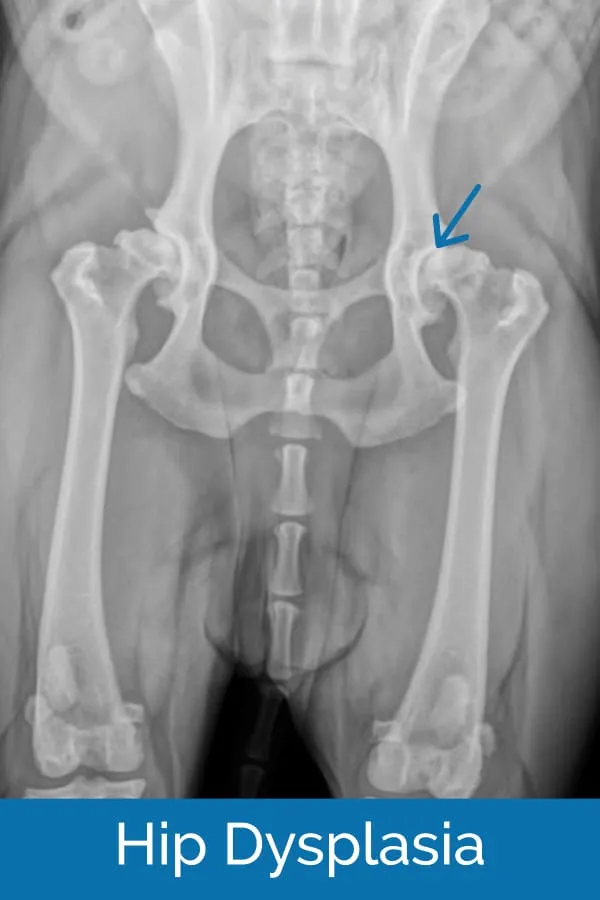 X-ray illustrating hip dysplasia in a dog with a shallow hip socketThis X-ray clearly shows a dog with hip dysplasia. Observe how the hip socket is noticeably shallower, appearing less like a “crescent moon” compared to healthy hips. Photo credit: Laura Putnam, DVM.
X-ray illustrating hip dysplasia in a dog with a shallow hip socketThis X-ray clearly shows a dog with hip dysplasia. Observe how the hip socket is noticeably shallower, appearing less like a “crescent moon” compared to healthy hips. Photo credit: Laura Putnam, DVM.
Comprehensive Treatment Options for Hip Dysplasia in Dogs
Treatment options for canine hip dysplasia are broadly categorized into surgical and non-surgical approaches. While this article focuses extensively on non-surgical methods, it’s beneficial to briefly acknowledge surgical treatments before delving into the comprehensive conservative management strategies. These non-surgical options are often key components of pain medicine for dogs with hip dysplasia, aiming to improve mobility and comfort without invasive procedures.
Surgical Treatment for Hip Dysplasia in Dogs
Surgical intervention can be the most effective option in specific cases, particularly for young dogs who have not yet developed significant arthritis. The most common surgical procedures performed for hip dysplasia in dogs include Juvenile Pelvic Symphysiodesis (JPS), Triple Pelvic Osteotomy (TPO), Total Hip Replacement (THR), and Femoral Head Ostectomy (FHO/FHNO). Each procedure offers distinct benefits depending on the dog’s age, severity of dysplasia, and presence of arthritis.
Detailed and concise information regarding each of these surgical procedures can be found on the American College of Veterinary Surgeons’ website. However, it is important to recognize that surgical treatments often come with substantial costs and significant recovery periods, making them inaccessible or undesirable for all owners. If surgery is not a feasible option for your dog, there’s no need to despair, as numerous effective non-surgical strategies exist to manage the condition.
Non-Surgical Treatments: The Best Pain Medicine for Dogs with Hip Dysplasia
A wide array of medical treatments, including specialized supplements, conventional Western medicine, and innovative alternative therapies, are available for managing hip dysplasia in dogs. While these methods do not cure the underlying biomechanical issue of hip laxity, their primary goal is to control inflammation and pain, thereby significantly improving a dog’s mobility and overall quality of life. Effective pain medicine for dogs with hip dysplasia is multimodal, addressing various aspects of the condition.
So, what are the most effective non-surgical treatment options for canine hip dysplasia? Let’s explore Dr. Buzby’s top 10 tips for the conservative management of hip dysplasia, focusing on how these strategies can alleviate pain and restore comfort.
 A golden retriever dog, often affected by hip dysplasia, illustrates the need for effective pain management
A golden retriever dog, often affected by hip dysplasia, illustrates the need for effective pain management
1. Weight Management: A Foundation of Hip Health
My first tip, while not a “medicine” in the traditional sense, often proves to be more impactful for my patients—and for owners—than many pharmaceutical options for hip dysplasia combined. Your dog’s canine body condition score plays an enormous role in maintaining joint health. Simply put, the more your dog weighs, the greater the stress placed on his or her joints. This direct correlation makes weight management a critical component of pain medicine for dogs with hip dysplasia.
Larger dog breeds are inherently more prone to developing hip dysplasia than smaller breeds. In these dogs, even being “slightly” overweight can translate into 10 or more extra pounds exerting detrimental stress on already compromised hips. This added burden exacerbates pain and accelerates joint degradation.
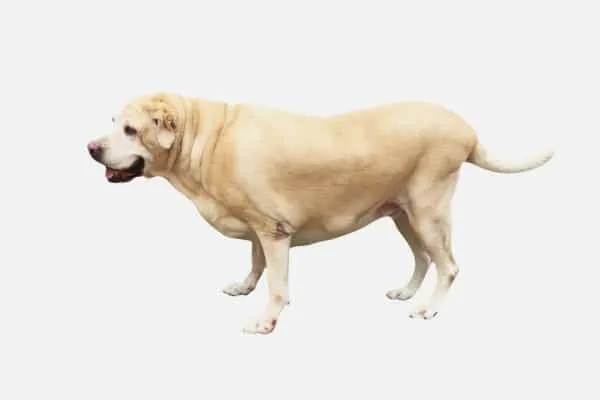 An overweight Labrador Retriever exhibiting hind limb muscle weakness, a common sign of hip dysplasiaThis overweight Labrador Retriever, a breed quintessential for hip dysplasia cases, displays muscle atrophy in its hind limbs, a symptom consistent with a diagnosis of canine hip dysplasia.
An overweight Labrador Retriever exhibiting hind limb muscle weakness, a common sign of hip dysplasiaThis overweight Labrador Retriever, a breed quintessential for hip dysplasia cases, displays muscle atrophy in its hind limbs, a symptom consistent with a diagnosis of canine hip dysplasia.
Beyond the physical strain of carrying excess weight, fatty tissue itself is metabolically active, producing inflammatory hormones that contribute to a state of chronic inflammation throughout the body. This persistent inflammatory response can significantly worsen osteoarthritis in the hips, amplifying pain and reducing mobility. Therefore, achieving and maintaining an ideal weight is a cornerstone of effective conservative management and provides invaluable pain relief for dogs with hip dysplasia.
2. Nonsteroidal Anti-Inflammatory Drugs (NSAIDs)
Nonsteroidal anti-inflammatory drugs (NSAIDs) are widely utilized in both human and veterinary medicine for managing pain and inflammation. When veterinarians discuss pain medicine for dogs with hip dysplasia, NSAIDs are typically considered a first-line treatment duedue to their effectiveness in reducing discomfort and swelling. Common NSAIDs approved for canine use include:
- Carprofen
- Meloxicam
- Firocoxib
- Deracoxib
- Grapiprant
By effectively decreasing inflammation and alleviating pain, NSAIDs can appear to work wonders for painful dogs, significantly improving their comfort and mobility. While these medications are generally considered safe when used as directed, it is important to be aware of potential side effects. If your loyal companion is on a regular NSAID regimen to manage osteoarthritis in dogs caused by hip dysplasia, your veterinarian may recommend routine bloodwork. This monitoring helps ensure that your dog’s organs, particularly the liver and kidneys, are tolerating the medications well. Ensuring proper administration can sometimes be a challenge, so explore tips for giving medication. For instance, sometimes a healthy pill pocket for dogs can make administering medication much easier.
(As a side note, I understand that prescribing helpful medication is only half the battle. Many dogs, including my own, are reluctant to take pills. If your dog turns his or her nose up at medications, explore effective tips, tricks, and techniques for what to do if your dog won’t take pills.)
3. Multi-modal Pain Management Strategies
If your dog continues to experience pain despite the use of NSAIDs, your veterinarian may suggest prescribing additional medications to achieve more comprehensive pain management. This approach, known as multi-modal pain management, involves using a combination of different medications and therapies to address pain through various pathways within the body. It’s a cornerstone of effective pain medicine for dogs with hip dysplasia when a single treatment isn’t enough.
Pain signals originating from the hips travel to the spinal cord and are then processed by the brain. Multi-modal therapy strategically targets these pain signals at different points along this pathway, effectively reducing the intensity of the pain signal perceived by the brain. This layered approach often yields superior pain relief.
Some of the commonly used medications for hip pain, prescribed either in conjunction with or as an alternative to NSAIDs, include:
- Gabapentin
- Amantadine
- Tramadol
Gabapentin
Gabapentin is frequently prescribed to help manage neuropathic pain and chronic pain disorders by modulating overactive neurons. It works by binding to voltage-gated calcium channels, causing neurons to fire less frequently. This action effectively reduces the transmission of pain signals, similar to how pregabalin (Lyrica) functions in treating pain in humans. Gabapentin for dogs is arguably the second most commonly prescribed traditional pain medicine for dogs with hip dysplasia, after NSAIDs, due to its efficacy in managing chronic discomfort.
Amantadine
Amantadine, initially an antiviral medication, has found a valuable role in reducing the chronic pain associated with osteoarthritis by increasing levels of dopamine in the brain and acting as an NMDA receptor antagonist, which helps to prevent central sensitization of pain. In one study involving dogs with hind-end osteoarthritis, a group given both an NSAID and amantadine showed more significant improvement in pain and increased activity levels compared to a group receiving only an NSAID. This demonstrates its potential as an adjunct pain medicine for dogs with hip dysplasia. For a comprehensive understanding, be sure to read my article on amantadine for dogs.
Tramadol
The medication Tramadol may also contribute to pain relief for dogs suffering from hip dysplasia. Current research suggests that Tramadol alone might be insufficient for managing the intensity of pain associated with advanced arthritis. However, it can be beneficial when used in combination with other pain medications. Tramadol works by increasing serotonin levels and having mild effects on the opiate receptors in the brain and spinal cord, thereby modulating pain perception. While it may not be a standalone solution, its role in a multi-modal pain management plan can enhance overall comfort. For more detailed information, please consult my comprehensive article on tramadol for dogs.
4. Joint Health Supplements/Nutraceuticals
I routinely recommend oral joint supplements for almost all of my hip dysplasia patients. While research into joint supplements—their precise benefits, optimal dosages, and absorption rates—is ongoing, most ingredients found in canine joint supplements are well-tolerated with minimal to no side effects. This makes them a worthwhile addition to pain medicine for dogs with hip dysplasia.
The primary joint health supplements commonly recommended are glucosamine and chondroitin. Despite some conflicting data regarding the extent of their benefit, I have anecdotally observed significant improvements, particularly when supplementation begins at an early age. These compounds are believed to support cartilage health and joint function.
Buyer Beware! The Joint Supplement Market
As hip dysplasia is the most common inherited musculoskeletal condition in dogs, affecting a vast number of animals, the market for its treatment, including joint supplements and “nutraceuticals,” is immense. It is crucial for owners to understand that joint supplements and nutraceuticals are not regulated by the FDA in the same way prescription medications are. This means they are not subject to the same strict testing and manufacturing requirements. Consequently, any company can formulate and market a “joint supplement,” with minimal oversight to ensure the accuracy of listed ingredients or the product’s actual efficacy.
Not All Joint Supplements Are Created Equal
A quick internet search for “dog joint supplements” will yield hundreds, if not thousands, of options. The quality and effectiveness of these products can vary dramatically. Therefore, it is imperative to consult your veterinarian before selecting any joint health product for your dog to ensure you choose a reputable and effective supplement.
In addition to glucosamine and chondroitin, many joint supplements contain other bioactive compounds that can contribute to joint health. Some notable examples include:
- MSM (methylsulfonylmethane)
- Avocado/soybean unsaponifiables (ASU)
- Various herbs such as turmeric/curcumin, bromelain, boswellia, corydalis, and devil’s claw
- New Zealand deer velvet – an ingredient I highly favor for treating dogs with canine hip dysplasia.
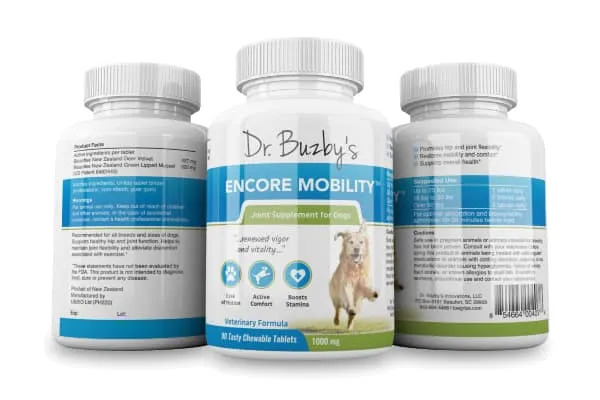 Three bottles of Encore Mobility, a joint supplement for dogs, recommended by Dr. BuzbyI personally recommend Dr. Buzby’s Encore Mobility™ Joint Supplement for Dogs to my clients. Formulated with New Zealand deer velvet and [green-lipped mussel for dogs](https://toegrips.com/green-lipped-mussel-for-dogs/), this supplement is designed to maintain and support healthy tissue, cartilage, and joints, offering a natural component of pain medicine for dogs with hip dysplasia.
Three bottles of Encore Mobility, a joint supplement for dogs, recommended by Dr. BuzbyI personally recommend Dr. Buzby’s Encore Mobility™ Joint Supplement for Dogs to my clients. Formulated with New Zealand deer velvet and [green-lipped mussel for dogs](https://toegrips.com/green-lipped-mussel-for-dogs/), this supplement is designed to maintain and support healthy tissue, cartilage, and joints, offering a natural component of pain medicine for dogs with hip dysplasia.
SHOP NOW
5. Omega-3 Fatty Acids for Anti-Inflammatory Support
Omega-3 fatty acids are a powerful natural anti-inflammatory agent, benefiting stiff, “creaky” joints throughout the body. I routinely recommend this supplement as a key component of pain medicine for dogs with hip dysplasia because it offers significant health benefits with minimal to no side effects. The numerous benefits of omega-3 fatty acids for dogs extend beyond joint health, supporting overall well-being. Regular supplementation can help reduce the inflammatory processes that contribute to joint pain and deterioration in dysplastic hips.
6. Adequan Injections for Cartilage Protection
I am also a significant advocate for Adequan injections in the treatment of dogs with hip dysplasia. Adequan Canine, a prescription polysulfated glycosaminoglycan (PSGAG), functions similarly to oral joint supplements by working to maintain the health and integrity of cartilage within your dog’s joints. However, because it is administered via intramuscular injection, it penetrates much more effectively into the joint tissues than oral products, leading to more targeted and potent effects. While it may not be effective for every dog, I have personally witnessed some remarkably dramatic improvements in patients receiving Adequan. For more comprehensive details on this valuable treatment, refer to my article on adequan for dogs.
7. Appropriate, Gentle Exercise and Rehabilitation
Appropriate, gentle exercise is paramount for maintaining musculoskeletal health in dogs, especially those with hip dysplasia. Research is continuously evolving regarding the optimal type, frequency, and duration of physical therapy in veterinary medicine. However, current studies suggest that appropriate exercise, rather than strict exercise restriction, is linked to lower lameness scores and improved joint function. As a firm believer in the principle of “use it or lose it,” this finding resonates logically with me as a veterinarian.
I am particularly enthusiastic about the increasing availability of canine rehabilitation practitioners and facilities, which offer advanced therapies such as underwater treadmills for dogs. These specialized programs provide controlled, low-impact exercise that helps build muscle strength, improve range of motion, and reduce pain without overstressing the compromised joints. To find a certified rehabilitation practitioner in your area, I recommend visiting the American Association of Rehabilitation Veterinarians’ website. Incorporating structured rehabilitation into a pain management plan is crucial for dogs with hip dysplasia.
8. Acupuncture and Laser Therapy: Alternative Pain Relief
Acupuncture for dogs and laser therapy for dogs are alternative treatments that have demonstrated significant success in managing dogs with hip dysplasia. These therapies can certainly be utilized individually, but I often find that they exert a synergistic effect when combined to treat dogs experiencing painful hips. Both offer valuable, non-pharmacological pain medicine for dogs with hip dysplasia.
Over the past two decades, I have performed acupuncture on hundreds of hip dysplasia patients, frequently incorporating electroacupuncture to amplify its therapeutic effects, with consistently positive results. Acupuncture promotes the release of endorphins—the body’s natural opioids—into the bloodstream, which helps to alleviate pain and induce relaxation in the dog. Additionally, it aids in relaxing the muscles of the lower back and hind end, which often endure abnormal stresses due to the dog’s chronic compensatory movements. I typically advise new clients that we should be able to determine the efficacy of acupuncture as part of their dog’s treatment plan within three visits, and often, noticeable improvement is observed after just the first session.
Laser therapy has been utilized in human medicine for decades before its successful integration into veterinary practice. Therapeutic lasers emit light that penetrates deep into tissues. This light stimulates cellular activity, increases blood flow to the treated area, and facilitates healing processes. Due to the advanced power of modern veterinary lasers, treatment sessions typically last only a few minutes. Dogs generally tolerate laser therapy exceptionally well, making it a comfortable and effective option for pain relief and tissue repair.
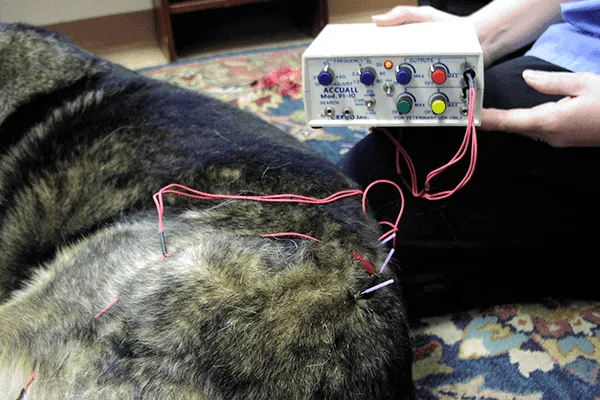 A German Shepherd dog undergoing electroacupuncture, a treatment for hip dysplasia, demonstrating alternative pain managementThis German Shepherd dog is receiving electroacupuncture as an integral part of her comprehensive hip dysplasia treatment plan, highlighting the effectiveness of alternative pain medicine for dogs with hip dysplasia.
A German Shepherd dog undergoing electroacupuncture, a treatment for hip dysplasia, demonstrating alternative pain managementThis German Shepherd dog is receiving electroacupuncture as an integral part of her comprehensive hip dysplasia treatment plan, highlighting the effectiveness of alternative pain medicine for dogs with hip dysplasia.
9. CBD Oil for Dogs with Hip Dysplasia
An area of rapidly growing interest in both human and veterinary medicine is the use of CBD oil for dogs. Cannabidiol (CBD) distinguishes itself from Delta-9 tetrahydrocannabinol (THC) because it primarily binds to receptors associated with reducing pain and inflammation throughout the body. Crucially, it does not bind to the receptors in the brain that induce the psychoactive effects commonly associated with THC, meaning dogs do not experience a “high.”
Recent veterinary studies have shown promising results, with dog owners reporting significant improvements in pain scores for their pets treated with CBD oil. Furthermore, these studies indicate enhanced mobility in dogs receiving CBD oil compared to those given a placebo. This early research suggests that CBD oil holds considerable promise as a natural pain medicine for dogs with hip dysplasia.
However, it is important to note that recommending and prescribing CBD oil currently exists in a legally gray area for veterinarians, with regulations varying significantly from state to state. Similar to other supplements, there is currently limited regulatory oversight of CBD products specifically for animals. Therefore, it is absolutely essential that you do not administer any over-the-counter medication or supplement, including CBD oil, to your dog without first consulting your veterinarian to ensure safety and appropriate dosage. As a helpful note, when dogs need heartworm medicine for puppies or adult dogs, or even general heartworm meds for dogs, it’s always crucial to consult a vet before combining with other treatments. Similarly, if your dog experiences digestive upset, finding the best anti diarrhea medicine for dogs or considering dog diarrhea medicine Petsmart options should also involve veterinary advice, ensuring safe interactions with hip dysplasia treatments.
10. ToeGrips® Dog Nail Grips for Enhanced Mobility
Dogs suffering from hip dysplasia often face significant challenges when trying to rise from or walk on slippery surfaces such as hardwood floors or tile. ToeGrips® dog nail grips are an innovative solution designed to help dogs who slip and slide, providing both improved footing and restored confidence. These nonslip grips fit snugly onto a dog’s toenails, effectively restoring traction on slick floors and smooth surfaces.
ToeGrips can make a profound difference in comfort and mobility for dogs with hip dysplasia. By preventing slips and struggles, they reduce the effort and pain associated with movement, allowing dogs to navigate their home environment more easily and securely. For an inspiring story about a senior dog’s transformation with ToeGrips, I encourage you to read “ToeGrips® for Senior Dogs: Bigsby’s Success Story.” This showcases how simple mechanical aids can be a vital component of pain medicine for dogs with hip dysplasia.
 A Labrador Retriever dog confidently wearing ToeGrips, designed to improve mobility on smooth surfaces despite hip dysplasiaHip dysplasia occurs more frequently in large and giant breed dogs, such as Labrador Retrievers. This particular dog is wearing ToeGrips® dog nail grips, which significantly enhance her ability to rise and walk on smooth floors without the common slipping or struggling often associated with hip dysplasia.
A Labrador Retriever dog confidently wearing ToeGrips, designed to improve mobility on smooth surfaces despite hip dysplasiaHip dysplasia occurs more frequently in large and giant breed dogs, such as Labrador Retrievers. This particular dog is wearing ToeGrips® dog nail grips, which significantly enhance her ability to rise and walk on smooth floors without the common slipping or struggling often associated with hip dysplasia.
Hip Dysplasia: A Condition with Many Effective Treatment Options
Ultimately, you, the owner, know your dog better than anyone else. If your dog with hip dysplasia is experiencing pain—evidenced by reduced activity levels or less interaction with the family—it is crucial to open a dialogue with your veterinarian about the available options. Pain is the foremost inhibitor of quality of life for my canine patients. If you’ve had a dog that suffered from hip dysplasia, you likely understand how excruciating the condition can become without appropriate intervention and pain medicine for dogs with hip dysplasia. Improving a dog’s physical and mental well-being through effective pain management not only brings relief to my clients and their beloved pets but also brings me immense joy as a veterinarian.
When it comes to treating the pain associated with hip dysplasia in dogs, a multimodal therapy approach is undeniably the most effective. This means that a combination of several of the 10 tips for treating hip dysplasia discussed in this article will yield the greatest success. It is important to remember that dogs, much like humans, may respond differently to various products and therapies, exhibiting individual variation in their response. Therefore, a personalized approach tailored to your dog’s specific needs and reactions is paramount.
As always, working closely and collaboratively with your veterinarian is critical to achieving the best possible outcome for your dog, ensuring they receive the most effective pain medicine and support for their hip dysplasia.
